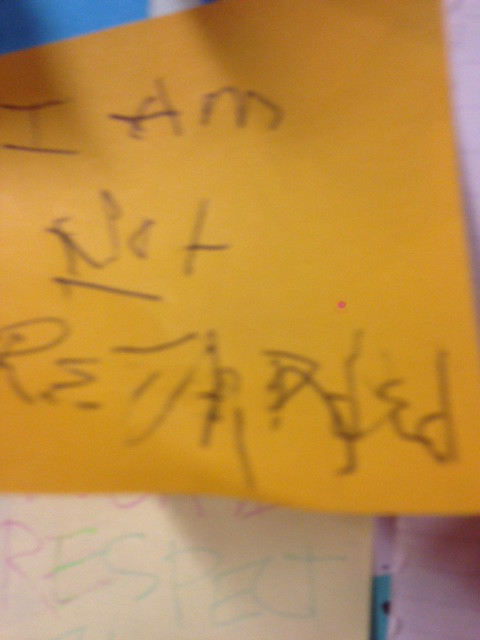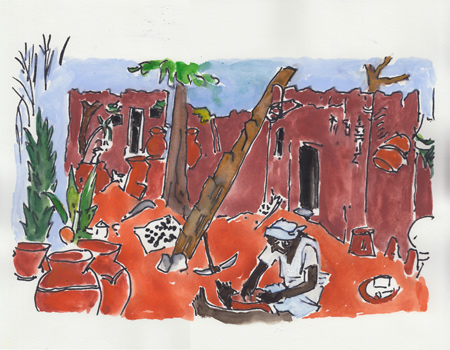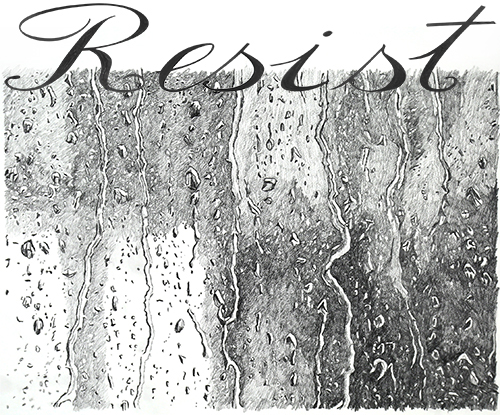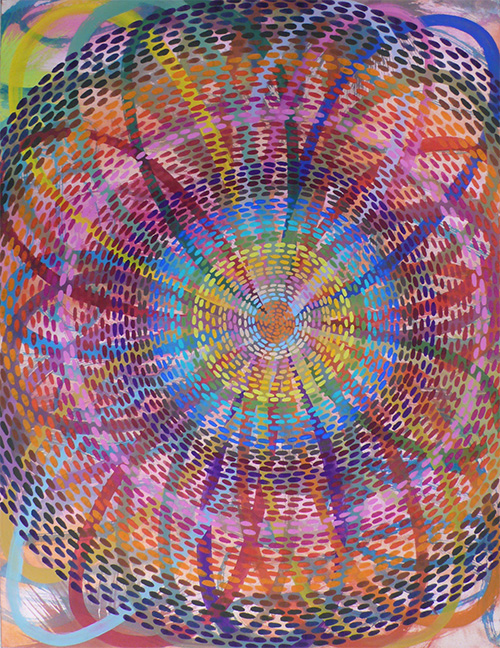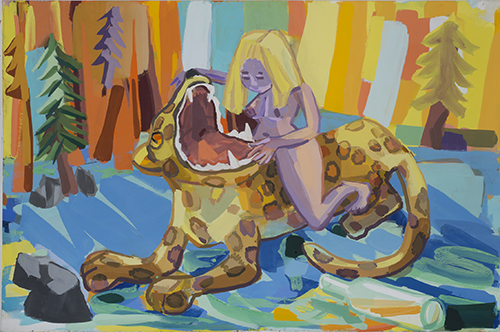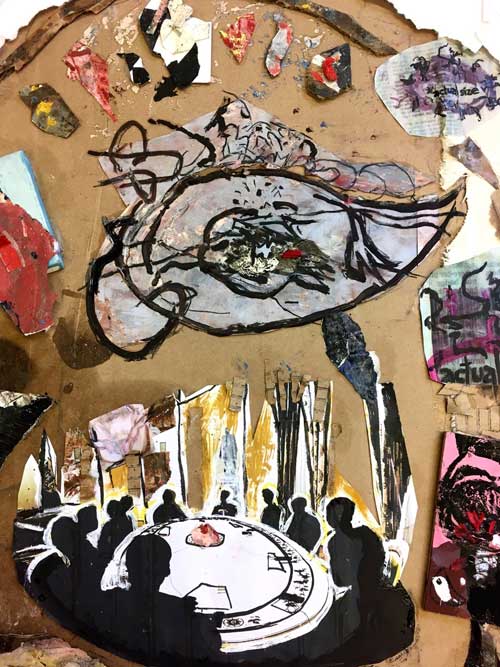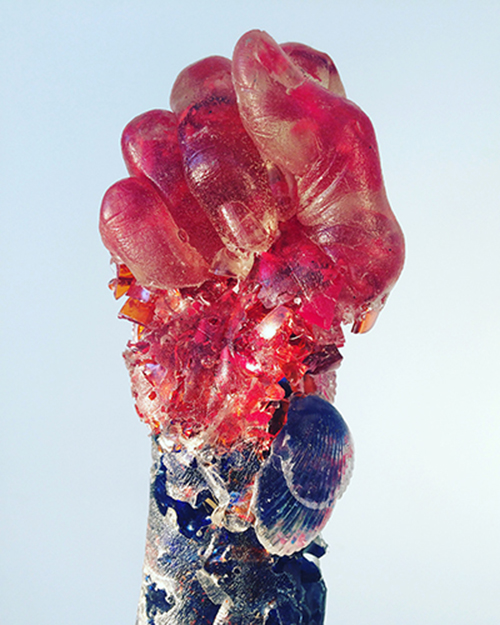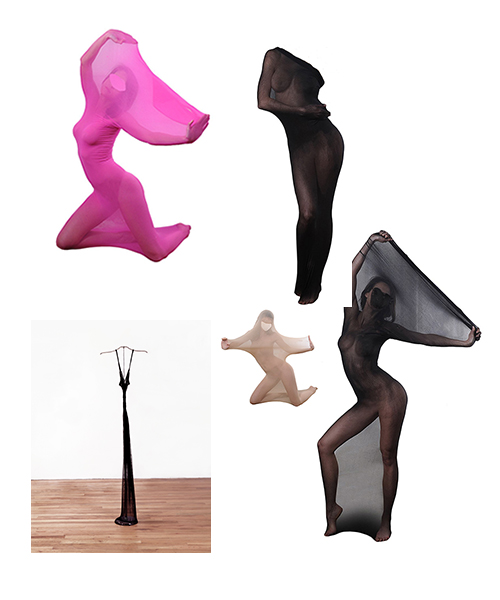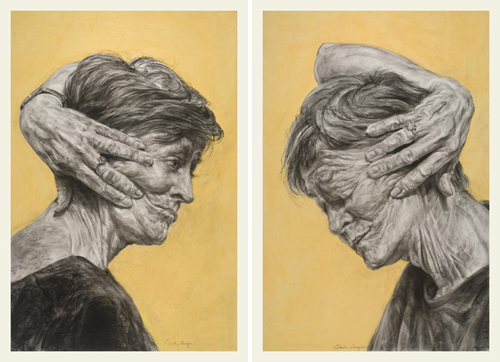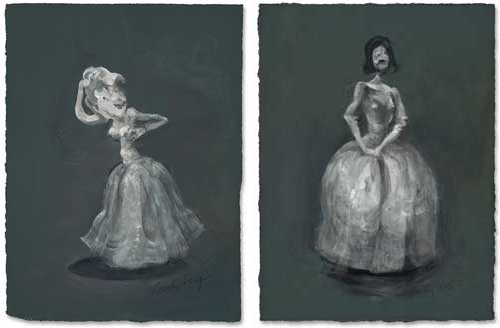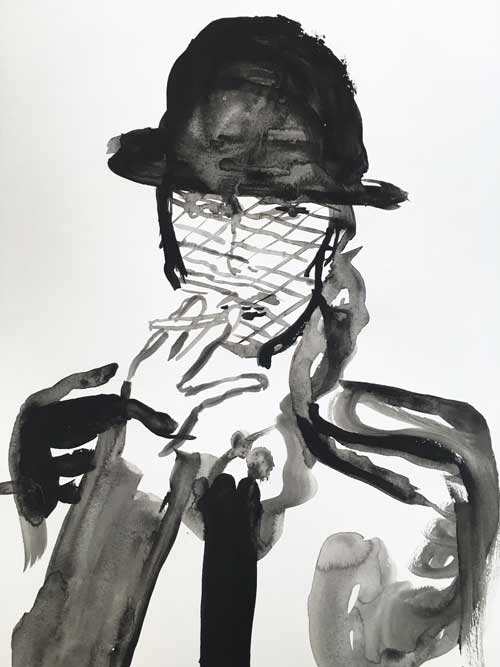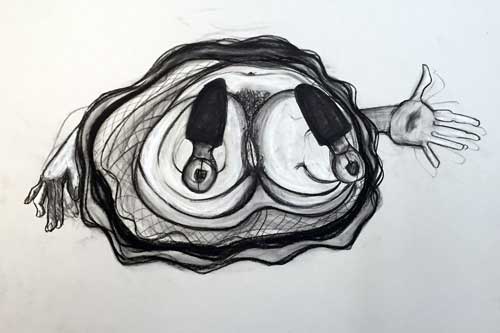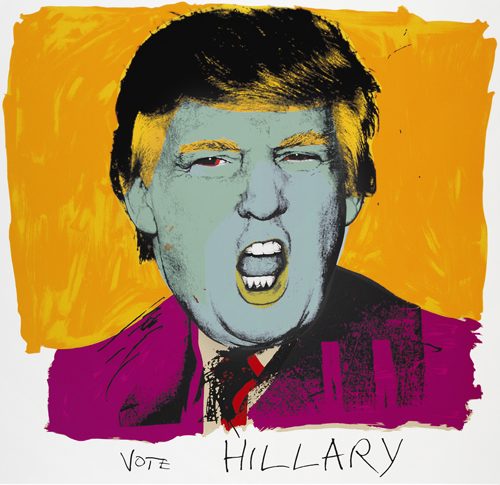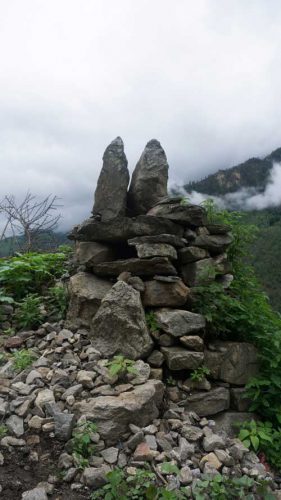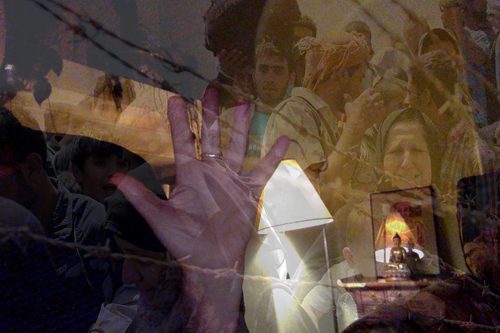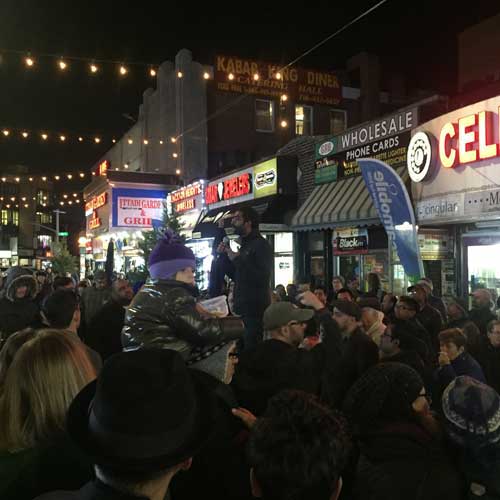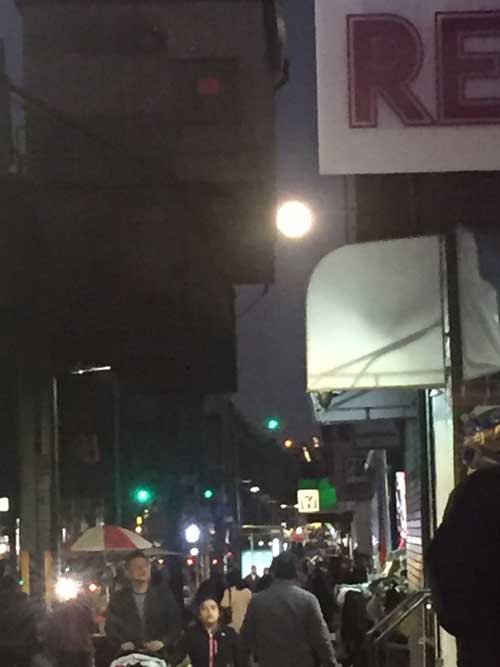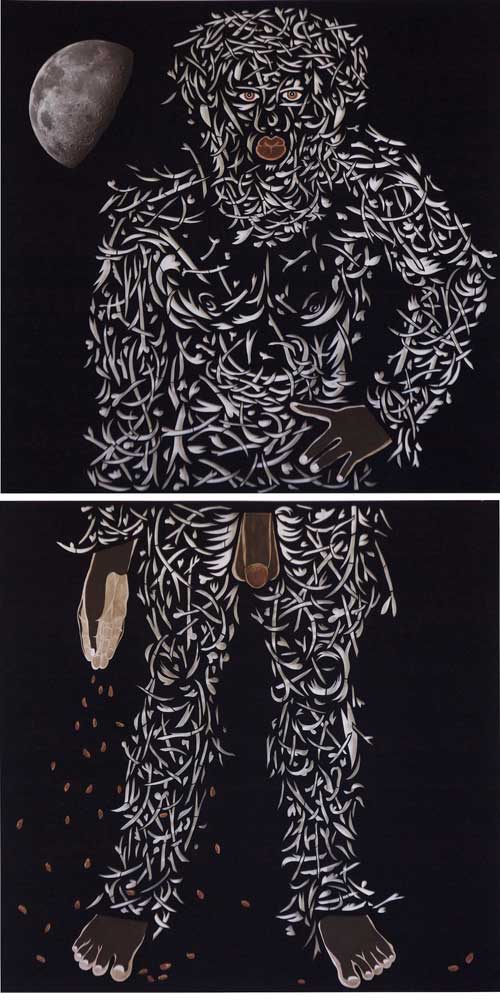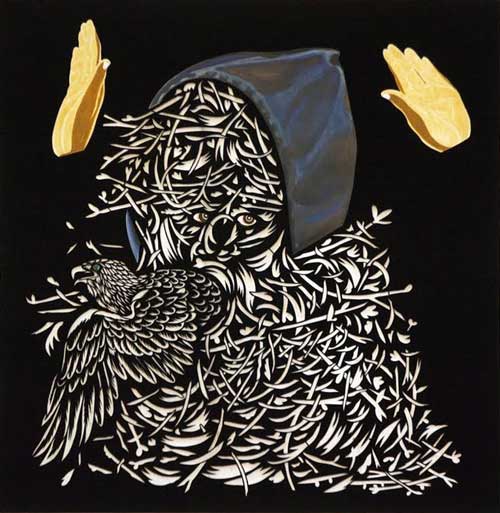The first issue of M/E/A/N/I/N/G: A Journal of Contemporary Art Issues, was published in December 1986. M/E/A/N/I/N/G is a collaboration between two artists, Susan Bee and Mira Schor, both painters with expanded interests in writing and politics, and an extended community of artists, art critics, historians, theorists, and poets, whom we sought to engage in discourse and to give a voice to.
For our 30th anniversary and final issue, we have asked some long-time contributors and some new friends to create images and write about where they place meaning today. As ever, we have encouraged artists and writers to feel free to speak to the concerns that have the most meaning to them right now.
Every other day from December 5 until we are done, a grouping of contributions will appear on A Year of Positive Thinking. We invite you to live through this time with all of us in a spirit of impromptu improvisation and passionate care for our futures.
Susan Bee and Mira Schor
*
Note to email subscribers: the videos in this post can only be viewed if you are online, they will not run in your email program.
*
Noah Dillon
2016 was a very difficult year. Each day’s news has been something horrifying, including intensifying effects from global warming, Syrian carnage, economic turmoil in Europe, refugee crises, authoritarianism in China and the Philippines, parts of Latin America suffering civil catastrophe. In the US, a white power presidency was voted into office. My cat and mom are dying, and a friend has terminal cancer. My sense of self continued to be a mess. I hurt people’s feelings, and had my feelings hurt.
The day after the election, my friend Brian Dunning, who runs a science blog and podcast called Skeptoid, sent out a solicitation for donations. He wrote:
“From the election results, we can infer that about half the American population is (at worst) openly hostile to, or (at best) ignorant or dismissive of, these science facts:
- Anthropogenic global warming is real and a threat.
- Vaccines are important and do not cause autism.
- Gay conversion therapy does not work.
- Evolution is the scientific theory explaining the diversity of species.”
I would, I think reasonably, add:
- Partial-birth abortions are a myth
- Trickle-down economics is magical thinking
- Trade is good and is not the cause of working class decline
- Crime and demographic data do not show white Americans under threat by black and brown youth, or a broad rise in crime generally
- Immigration is an essential good
- Elections are rigged by statehouses and wealthy super PAC donors, not poor voters
- Authoritarian police states do not keep people safe from anything, least of all the state itself
One place I find meaning is in meaning itself. As far as I can tell, truth has been in a precarious civil position for a long time, with its value waxing and waning. Maybe cynicism and ideological closedness, rigidity, onanism are ascendant—they feel that way. Although it was most evident recently in the deluge of Trumpian trolling, this problem is pervasive on both the left and right: dissenting or even qualifying voices are suspected of being paid shills for George Soros or the Kochs, consensus is regarded as an oppressive imposition on personal freedom of disbelief, complex problems are constricted down into absurd dichotomies, the moral imperative to focus first on materially and spiritually enriching oneself reigns, and so on. These are huge problems!
(The president-elect seems to embody them perfectly: he is paranoiac, believes in a completely alternate reality, speaks out of both sides of his mouth while wielding a club, and seems most interested in himself, while promising that each supporter’s personal individual desires will be fulfilled. Although he played the Rolling Stones’ “You Can’t Always Get What You Want,” his message on the campaign trail was that he will make it possible for people, certain people, to have everything they want. He is the vile man of our era.)
Reliable and true information is essential to a functioning democracy, and likewise the ability to openly, skeptically, systematically hear new information, test it, and accept it, reject it, qualify it, contextualize it, remain uncertain of it. That’s really hard to do, and we’ve been encouraged to eschew it, or use it selectively. The insistence on meaning and truth, even in spite of its incompatibility with our beliefs, is really essential.
Agreement about facts ought to lead to moral policies and objectives. Moralizing in the absence of fact, conversely, I think, is tilting at windmills. There are some extremely difficult problems facing the world right at this moment. Really horrifying terrible problems. Only by knowing what they actually are—honestly—and openly approaching possible solutions, or at least mechanisms for harm reduction, can they be solved.
Knowing what the world is, and what its problems and solutions are, means a lot.
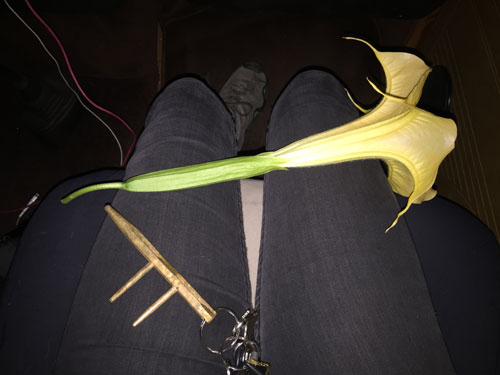
Photo by Davina Semo, 2016
Noah Dillon is an artist and writer living and working in New York.
*
Felix Bernstein and Gabe Rubin
Transitions are always hauntingly incomplete. The badly transitioned, like Frankenstein’s monster, is the site of ridicule and fetish. The transition that does not work, or does not work out, is ridiculed since according to Derrida, “it is always non-work that is stigmatized.” To manage this, the awkward transition must be streamlined into disciplinary criteria of excellence, the good hybrid—the body without organs who can parody gender, whilst emphasizing precarity, matter, ethics; while remaining virtual, ironic, mutable; and self-critically recognizing that this is all “neoliberal,” and meant to be surpassed. When Gabe’s voice started changing, we were unable to find the joy in the “radical de-skilling” at play, which vis-à-vis the queer art of failure seems to be an ineradicable avant-garde norm. But the horrific core of Gothic hauntings and romantic nostalgia powered us through.
In our recent videos “Landslide” and “There Are Worse Things”—Gabe hangs onto the cracked, destroyed, pseudo soprano boy voice; Felix repeats, layers, and amplifies his voice to the point of erosion. The point between visible and invisible; layered and bare; maximal and minimal lies between us—through which, we critique, imitate, and clone each other’s failed ‘realness.’
Like Dorian Gray, we all carry the portrait of the un-sexy rotting corpse inside ourselves, a picture that is continually ghosted by others. Loss in an age of “photogenic” tolerance comes when you can’t transform your vulnerability into an Instagram ready look. Ghosts of course show up on camera. But today’s specter is the unphotogenic ghost, or the suffering that cannot be rallied around vis-à-vis an Instagram campaign with a catchy Hashtag. These are our ghosts: of the poorly transitioned, the creaturely, the unnoticed, and the barely visible.
Felix Bernstein is the author of Notes on Post-Conceptual Poetry (Insert Blanc Press) and Burn Book (Nightboat). His writing has been featured in Poetry Magazine, Hyperallergic, and Texte Zur Kunst. With Gabe Rubin, he presented the shows Bieber Bathos Elegy at the Whitney Museum of American Art, and Transition Incomplete at MOCA Los Angeles.
Gabe Rubin is a musician, performer, and artist. His work has been shown at MIX NYC, the Brooklyn Film Festival, and MOCA Los Angeles. He recently performed in Jill Kroesen’s Collecting Injustices, Unnecessary Suffering at the Whitney Museum of American Art and Cecilia Corrigan’s Motherland at Issue Project Room.
*
Elaine Angelopoulos:
What is Meaning? How do I make art and perform activism now?
Meaning as a noun has often felt obstructive but significant in making a statement.
Since the election, I have found myself starting to come to several conclusions, and have felt the need to participate in political activism differently than I have in the past. My art methodology seems more in tune with chaotic times like these: I have a work structure that allows diverse modes of creativity, conceptualism, object, content, and interaction with the greater world.
Meaning as an adjective allows more flexibility to the way I express myself, because it doesn’t require art as a concrete series of works that appear consistent. The paternalistic cultural taboos I experienced during my childhood and challenged during my adolescence in the 1970s, were not self-identified as feminist or queer until my early adulthood in the 1990s, largely because of the socially phobic strife between movements under the cold war theater and the narrow strains of the singular narratives in the canons of art, humanities, and the sciences.
My own work as a studio artist was comprised of drawings, objects, and installations that were more formally abstract and devoid of narrative or political content. My collective projects and performance works were more welcoming of accumulative objects and conformed toward a more subjective approach toward content. The work I started to do in the late 2000’s started to delve into the messiness of aesthetics, memory, personal narrative, and greater narratives, and the lessons that intersect through time and space. We embody these lessons like layers of skin within an onion and we forget they are there until we peel it back to see how different they are from one another (all within moments before they are enfolded back into a neat package within ourselves).
The power of meaningful activism is often short lived in a collective group form unless there is a long-term definitive set of strategies in place that maintains multiple modes of progress. But both forms of activism work in tandem to one another, just as art that requires daily exploration in the studio complements the more utilized forms and symbols that sustain directed feelings and reactions to particular differences in the political theater. I have been finding meaning in the everyday, even now in the post-election period. This is where the answers for change dwell. We can create incremental moments of intervention against racist and sexist slurs in public places by overcoming our silent stand and by stepping in and offering ourselves as direct allies to those being attacked. Confront rhetoric and misinformation by speaking up in conversation to those who attempt to incite fear or normalcy in the current political climate.
If we are any smarter, perhaps we ought to go beyond the metaphorical references of “taking a stab at it,” which one may associate with Melville’s Moby Dick. Though this slang term originates from the 1800s, we can make the correlation to today, where we are stabbing at a giant whale that may eventually overwhelm and consume us. Somewhere between the phenomena we call art and dialogue, one hopes that not too many layers of time require a peel back to find answers to the “politics in our rooms.”[1]
[1] Referencing Gregg Bordowitz’s public moving image project, “The Politics in the Room,” created by the LUX Associate Artists Programme, in 2009.
This video piece was composed in 2008 from documentation shot at the 9th Annual Dyke March in New York City from late June 2001. This media was used for a performance work in 2010 under the pseudonym of “Activista,” a persona that is part of the ensemble of “The Nested Selves.”
Elaine Angelopoulos lives and works in New York City. She is an artist with an interdisciplinary approach that bridges her studio practice with audience participation. Angelopoulos received a Franklin Furnace Fund/Jerome Fellowship in 2014/15. Recently, her work was included in the Labin Art Express Biennial, “Utopia=Reality,” in Croatia; and in “Project for Revolution in New York,” at the Tompkins County Public Library in Ithaca, NY. Angelopoulos wrote a chapter about her work in Poetic Biopolitics, (I.B. Tauris, 2016). She has been a participant in numerous art collectives. She is a staff member at Ronald Feldman Fine Arts.
*
Alexandria Smith
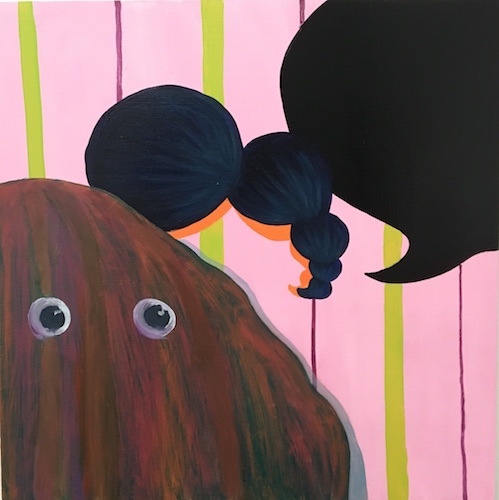
Alexandria Smith, “what had happened wuz,” 2016. Oil on panel, 24” x 24.”
“what had happened wuz” is a painting that evokes how I’ve been feeling at this tense and scary time. It was created during my time as Virginia A. Myers Visiting Artist in Printmaking at the University of Iowa, during the 2016 Democratic caucuses and is still very relevant. I recently participated in the New Museum’s seminal event Black Women Artists for Black Lives Matter. BWA for BLM is an underground collective that focuses on the interdependence of care and action, invisibility and visibility, self-defense and self-determination, and desire and possibility in order to highlight and renounce pervasive conditions of racism through the arts.
Alexandria Smith has a BFA from Syracuse University, MA from NYU, and MFA from Parsons The New School for Design. Smith is the recipient of a Pollock-Krasner Grant, Skowhegan Fellowship, Virginia A. Myers Fellowship at the University of Iowa, an A.I.R. Gallery Fellowship, and the Fine Arts Work Center Fellowship. Recent exhibitions include a solo show at Scaramouche Gallery, a commission for the Schomburg Center, a group show, “Black Pulp,” at Yale University and International Print Center NY, and in 2017, a solo exhibit at The Union for Contemporary Art, Omaha, NE. Smith has been featured in the Huffington Post: “Alexandria Smith’s Adorably Grotesque Cartoons Explore What Little Girls Are Made Of.” She lives in Brooklyn, NY, and Wellesley, MA, where she is Assistant Professor of Studio Art at Wellesley College.
*
Joyce Kozloff
In light of the devastating election returns, I could not write a statement that said more than the eloquent words expressed by many others. Nor could I make an image to express those feelings, so this is some silly stuff I found on eBay. Globalism?
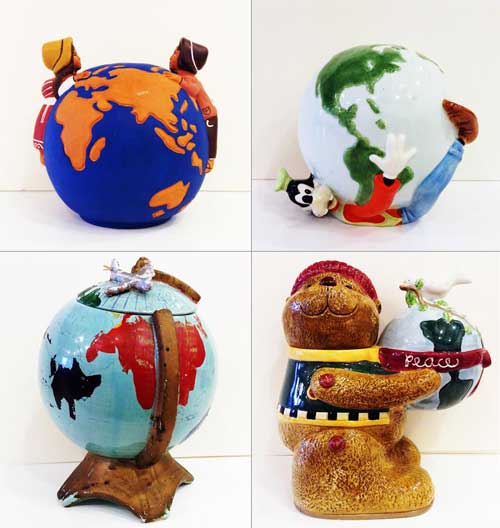
Joyce Kozloff is an artist and political activist who lives in New York.
*
Tamara Gonzalez and Chris Martin
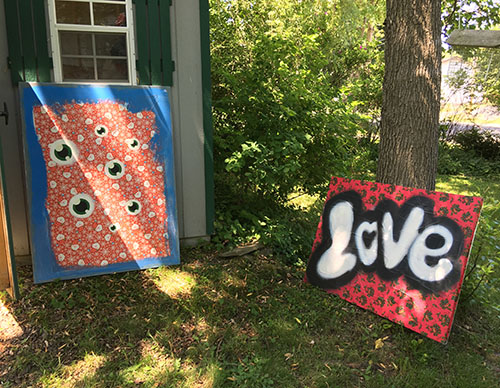
Tamara Gonzalez, “Untitled” and “Love 2010” from “Christmas in July”
I found this photo of two old paintings of Tamara’s. It made me think that in dark times – keep your eyes and heart open. —Chris Martin
Tamara Gonzales and Chris Martin are living and making art in Brooklyn and the Catskills in New York.
*
Legacy Russell: AN ANATOMY OF MOURNING
Grief is positive!
GRIEF IS NEGATIVE
Grief is proactive!
GRIEF IS PARALYSING
Grief is productive!
GRIEF IS CAPITALIST
Grief is reproductive!
GRIEF IS STERILE
Grief is useful, it galvanises me!
GRIEF IS LABOUR, UNPAID
Grief is movement!
GRIEF IS STANDING STILL
Grief is progressive!
GRIEF IS FASCIST
Grief is helpful!”
GRIEF IS COERCIVE
Grief is public!
GRIEF IS PRIVATE
Grief is active!
GRIEF IS LAZY
Grief is strong!
GRIEF IS WEAK
Grief is proud!
GRIEF IS SHAMEFUL
Grief is empowering!
GRIEF IS FEARFUL
Grief is realistic!
GRIEF IS DELUSIONAL
Grief is radical!
GRIEF IS COUNTERREVOLUTIONARY
Grief is relief, I am relieved to grieve!
GRIEF IS EXHAUSTING, I AM FUCKING EXHAUSTED
Grief is collective!
GRIEF IS LONELY
Grief is truthful, it is honest!
GRIEF IS A LIAR, IT IS FRAUDULENT
Grief is calling your MP!
GRIEF IS HANGING UP
Grief is voting down ballot!
GRIEF IS NOT VOTING
Grief is self-care!
GRIEF IS HARMFUL
Grief is pragmatic!
GRIEF IS INEFFICIENT
Grief is volunteering!
GRIEF IS SELFISH
Grief is hopeful!
GRIEF IS CYNICAL
Grief is writing letters!
GRIEF IS WITHOUT LANGUAGE
Grief is speech!
GRIEF IS SPEECHLESS
Grief is showing up!
GRIEF IS STAYING HOME
Grief is relevant!
GRIEF IS IRRELEVANT
Grief is visible!
GRIEF IS INVISIBLE
Grief is a riot!
GRIEF IS A PARADE
Legacy Russell is a writer, artist, and cultural producer. Born and raised in NYC’s East Village she is the UK Gallery Relations Lead for the online platform Artsy. Her work can be found in a variety of publications: BOMB, The White Review, Rhizome, DIS, The Society Pages, Guernica, Berfrois and beyond. Holding an MRes of Visual Culture with Distinction at Goldsmiths College of University of London, her academic and creative work focuses on gender, performance, digital selfdom, idolatry, and new media ritual. Her first book Glitch Feminism will be published by Verso in 2017. Twitter: @legacyrussell | Instagram @ellerustle. |
*
Nancy K. Miller: Trump and his cabinet meet their fate
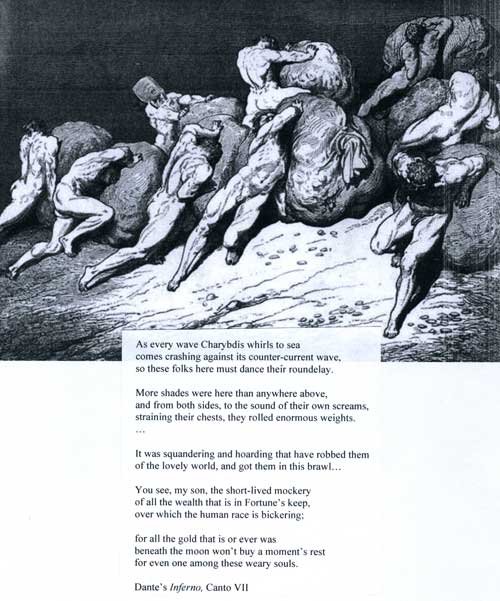
Nancy K. Miller teaches in the English and Comparative Literature Programs at the CUNY Graduate Center. Her most recent book is the memoir Breathless: An American Girl in Paris.
***
Further installments of M/E/A/N/I/N/G: The Final Issue on A Year of Positive Thinking will appear here every other day. Contributors will include Altoon Sultan, Aziz+Cucher, Aviva Rahmani, Erica Hunt, Erik Moskowitz + Amanda Trager, Hermine Ford, Jenny Perlin, Joy Garnett and Bill Jones, Julie Harrison, Kat Griefen, LigoranoReeese, Michelle Jaffé, Noah Fischer, Robert C. Morgan, Roger Denson, Susan Bee, Mira Schor, and more. If you are interested in this series and don’t want to miss any of it, please subscribe to A Year of Positive Thinking during this period, by clicking on subscribe at the upper right of the blog online, making sure to verify your email when prompted.
M/E/A/N/I/N/G: A History
We published 20 print issues biannually over ten years from 1986-1996. In 2000, M/E/A/N/I/N/G: An Anthology of Artists’ Writings, Theory, and Criticism was published by Duke University Press. In 2002 we began to publish M/E/A/N/I/N/G Online and have published six online issues. Issue #6 is a link to the digital reissue of all of the original twenty hard copy issues of the journal. The M/E/A/N/I/N/G archive from 1986 to 2002 is in the collection of the Beinecke Library at Yale University.

![Jennifer Bartlett, A few days after the election a pop-up artist/therapy piece began growing in the Union Square subway station. Passersby were encouraged to write a message to the world [in response to the election] on a "sticky note."](https://ayearofpositivethinking.com/wp-content/uploads/2016/12/Jennifer-Bartlett_Image_One.jpg)
